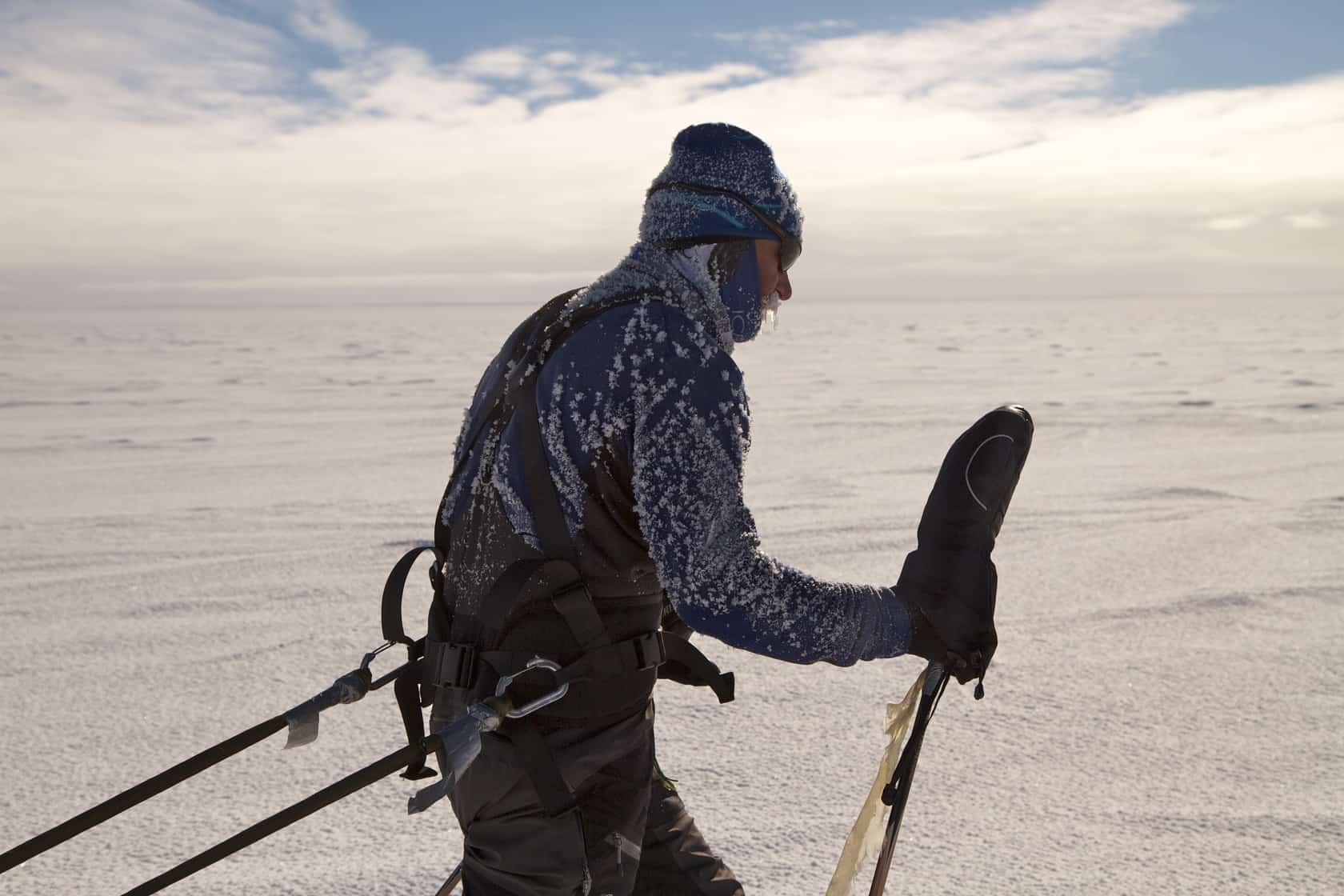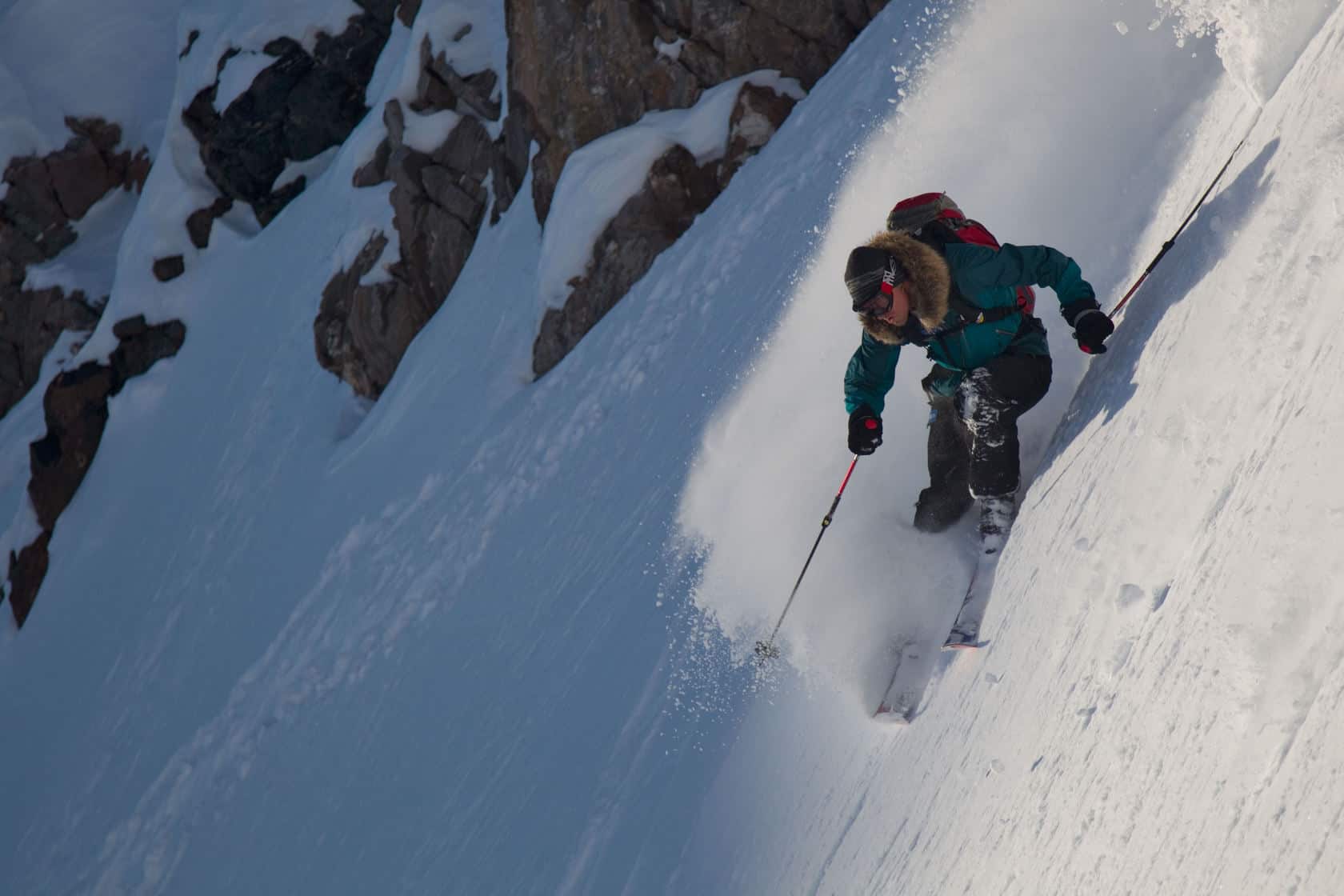“One morning I look outside the tent and I see this guy toe to toe with a polar bear, trying to keep his distance from it with a shovel and his pants down to his ankles”.
At 53 years old, Douglas Stoup is both the messenger and the message. Out there on the Poles he keeps in check what very few have seen and probably ever will see, including big white hairy man hunters. Adventurer by heart, environmentalist by passion, he is the most acclaimed extreme cold-weather guide and expedition leader in recent history. He’ll gladly take you along in the cold anytime—as long as you donate lots of money to compensate for your ugly carbon footprint and help build a better world as well as become a better human being in the long term. Amen.
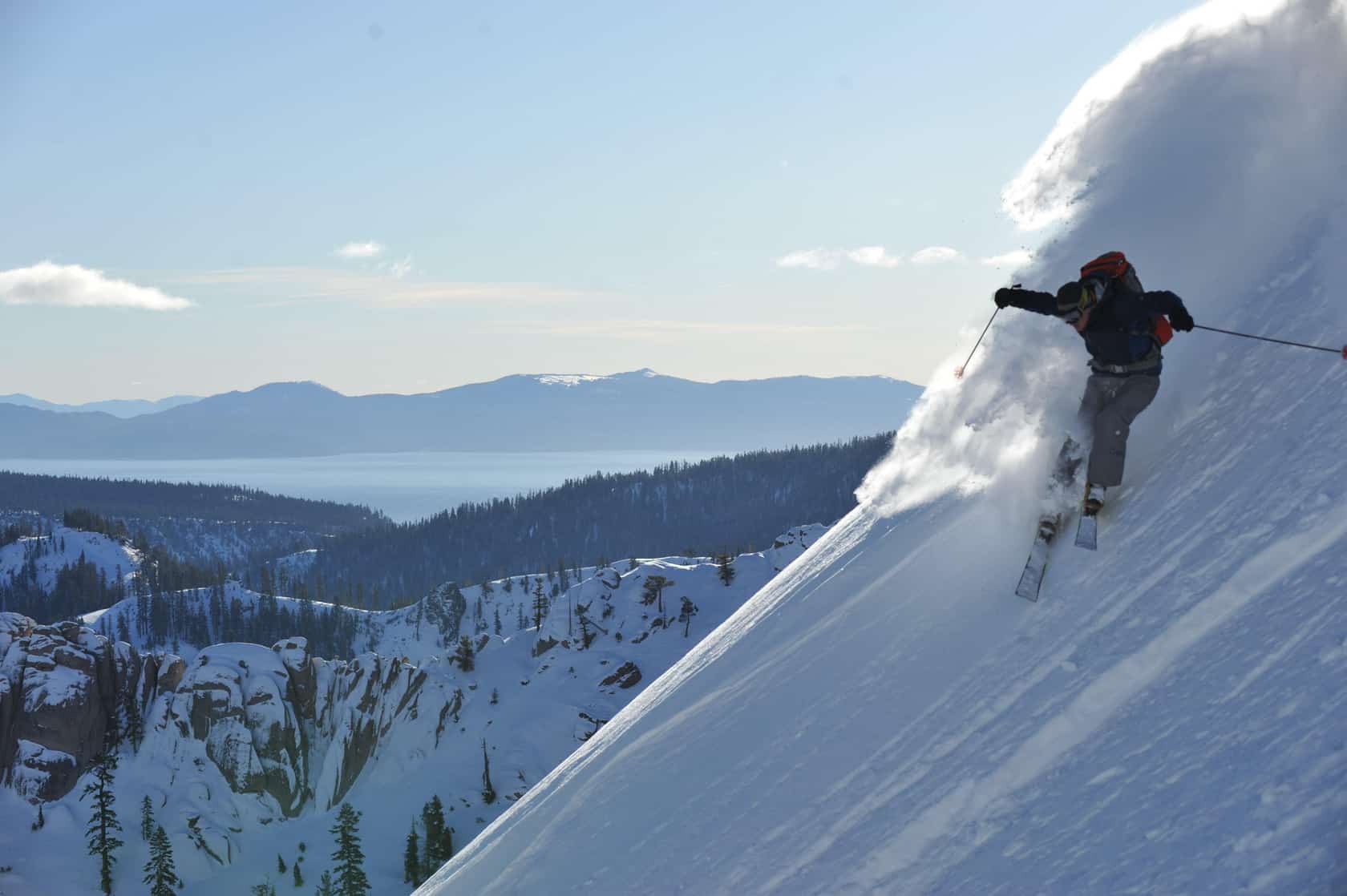
Gaël Couturier: Can you quickly tell us about your background: Where did you grow up? What did your parents do? And more importantly: What kind of a kid were you?
Douglas Stoup: I was born in Germany, near Frankfurt. My dad was an American soldier and we stayed there for three years. He left my mum when I was 7 and I never had a real tight father-son thing after that. I grew up in central Pennsylvania. I got a college scholarship to play soccer and graduated with a bachelor’s degree in business and economics from West Virginia University. After that I kind of accidentally ended up in Los Angeles and worked in the film industry, mostly as an athletic actor for advertising. I also did a few appearances in Baywatch and other popular stuff, but it wasn’t like it was something I always wanted to do.
Gaël Couturier: Baywatch must have been fun!
Douglas Stoup: Well yeah, but I had no real inner desire to do this. I mean, I wasn’t a trained actor or anything like that. My agent would send me out because I had the right look and the right skills. I did fairly well; I must have done around 100 international commercials. I would go to the Caribbean for three weeks and kayak for a beer commercial. Then I started doing more aerial rigging for feature films, including Cliffhanger with Sylvester Stallone and Shutter Island with Leonardo DiCaprio. My job was to rig the actors on cliff faces. It was pretty good money. I’d be away for six months, working six days a week with zero occasion to spend it.
I had put a lot of money aside and living the life, you know? I didn’t have a house—I rented a small place in Venice, California. I owned a car and that was it. I basically had a very free lifestyle, traveling the world from Thailand to Bali to New Zealand to Alaska and Chamonix, of course. I would go to Chamonix, the climbing mecca, with a couple of friends, months at a time, ice climb some summits with my snowboards on my back and then head down through all those classic “couloirs” that I had read about or seen on TV. We also were rappelling ourselves on those huge faces—doing it again and again. This was so much fun. I was a lot into climbing, skiing and mountaineering, and that’s when I grew interested in learning more about mountain and cold-weather survival skills.
But at that time, early- to mid-90s, I never thought I would be the first American to ski in the South Pole or the first to ice bike for long distance in Antarctica. My first South Pole trip was with a blind friend. We went 780 miles, lasting 62 days. In 2003 I went to the North Pole for the first time, and in 2005 I skied from Siberia to the North Pole. I think I’ve done more South Pole ski trips than anybody on the planet. I have done 15 North Pole trips and 15 South Pole trips. There are only 16 master polar guides and less than 30 people that have skied from the coast to the pole. In comparison, 7,000 people have climbed Mount Everest. The poles are definitely a niche market, but I don’t know how many years we can continue the trips because the environmental issues there are scary. I have seen lots of changes over the last 10 years. Too many.
What I do today is not so much about risk taking; it’s more about living to the fullest.
Gaël Couturier: You got into the movies by accident, in the whole guiding thing by accident—that’s a lot of accidents for a professional who takes risk for a living…
Douglas Stoup: I know! I’ve always liked adventures, but I swear I didn’t know I was going to be good at the whole guiding thing. I’m talking about my skills that help me understand people’s needs and objectives in order to handle them in really risky situations. It’s a question of setting the right balance. It’s a trick and it’s just my thing. I just love doing that. I enjoy the challenges and at the same time, Mother Nature super humbles me all the time. As a young man, I read most of the real explorers’ books: British Ernest Henry Shackleton, Australian Douglas Mawson, British Captain Robert Falcon Scott or Norwegian Roald Engelbregt Gravning Amundsen. Those were the true explorers of our time. I have always dreamed about what it must have been like for those guys, but I never thought I would kind of be walking in their footsteps, ever. I consider myself an adventurer, not really an explorer. The majority of my year I step where no human has stood before, but I certainly have a safety net that keeps me secure to continue to do these things: I carry a satellite phone, a warm sleeping bag and I have planes waiting for a distress call to pick me up. Those men before me were the real deal. They had no idea where they were going, they had no GPS, they were using sextant and navigating by looking at the stars. They basically had nothing, and they were the true sufferers. That’s why I have tremendous respect for them. They went in all the way, in a “till death do us part” kind of philosophy. What I do today is not so much about risk taking; it’s more about living to the fullest.
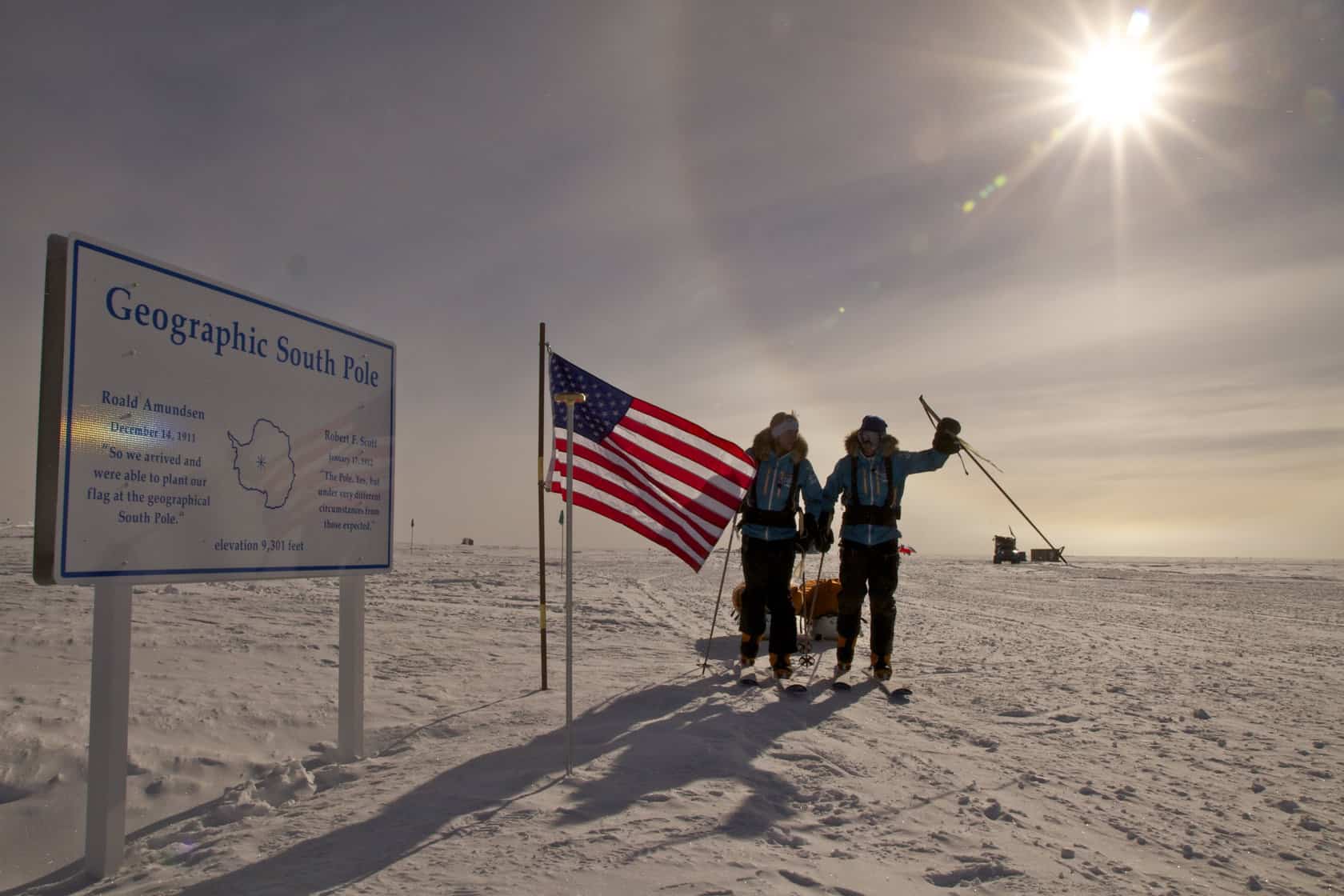
Gaël Couturier: Today you travel the world from Antarctica to Thailand or the Amazon. You go where few people go, you experience intense situations that most have no idea can occur. and sometimes even risk your life. I get that you are living fully, but what exactly are you looking for in those remote places that you can’t find in California?
Douglas Stoup: I love the United States. I have been to every state and I want to continue to explore them. But to live fully I need to be pushing the limits of human endurance. I can’t help it. I am not really looking for anything in life other than adventures. But also, I have found that the planet is very fragile and sometimes changing right in front of me. So if I can bring some awareness to the problems I am witnessing through my trips, then hopefully we can change or at least detour that path. I also love to ski, which is a big part of why I do all this. And there are so many amazing places that I have yet to discover. For me it’s not about monetary compensation or fame or whatever you want to call it: it is about living an adventurous life. I am well prepared to use my experience and knowledge for everything that comes. And I am meticulous in my preparation—it’s important to know I can rely on my gear.
Gaël Couturier: Right. Tell us about your prep for this upcoming expedition called Pole Of Hope with a young Swedish paraplegic, Aron Anderson [aronanderson.se], who contracted cancer at 7 years old and ended up in a wheelchair at 9. You guys are attempting to ski from the Leverett Glacier, Antarctica, to the South Pole this December. Is this correct?
Douglas Stoup: Yes, it’s roughly a 310-mile (500 km) adventure. I hold the world record for the fastest-ever unsupported walk from the Leverett Glacier on the edge of Antarctica [Ross Ice Shelf] to the South Pole. The previous record, set in 2011 by 35 year old Norwegian Christian Eide on a slightly different route, was 24 days. In December 2013, I did it in 18 days, 4 hours and 43 minutes, with a 19-year-old kid, Parker Liautaud [willisresilience.com]. I think I can make the trip in 14 to 15 days if I have two strong athletes or polar experienced tough guys with me. I actually plan on doing this next year with a couple of well-trained friends. But the trip with Aron Anderson is probably going to take us 30 to 40 days.
Guiding is what I do, yet in the end, this is his expedition. At the finish line, I’m not going to be standing at the Pole. He is.
Gaël Couturier: 30 to 40 days in the South Pole, without your legs, how is that even possible?
Douglas Stoup: Aron is very tough. He has been an official Paralympics athlete; he’s climbed Kilimanjaro, done long-distance triathlons, long-distance open water swimming. Today he’s raising money for the child cancer foundation that helped him as a kid [poleofhope.com and barncancerfonden.se]. He’s already done a bunch of incredible stuff, but this is definitely the most ambitious thing for him and it’s also going to be the hardest, partly because he’s not completely familiar with such a cold environment. He’s always had a lodge to go to and people to take care of him. For something like this, he and I have to think completely outside the box. Aron can’t feel his feet anymore so we have to make sure that I can constantly ensure that his feet are warm enough. I don’t know if that means taping a thermometer to his toes and running a wire to a temperature gauge to his stomach, or using a heated foot bed or an elephant foot sleeping back that goes over his leg. I will constantly have to think about stuff that he won’t think about on his own because he hasn’t really been in such environment. Of course his friends and family are depending on me to keep him safe. Does he have the will power? Yes.
Gaël Couturier: Unbelievable. It looks like it’s going to take a lot of heart and hard work.
Douglas Stoup: It certainly will. I have been with him on 10-days expedition near the Arctic Ocean so I know the kid has heart. It is the key element of success in any of those trips. Is he going to be ready? No choice. Am I going to be ready? Absolutely. I’ll do the things that need to be done before we go. Sometimes I don’t want to, but that’s key if you want to be successful. I keep bothering him all the time: Have you tested this? Have you done that? I constantly check on him, but I also want him to own the expedition. Guiding is what I do, yet in the end, this is his expedition. At the finish line, I’m not going to be standing at the Pole. He is.

Gaël Couturier: Let’s get down to earth with more accessible stuff for average people. Most in our societies are not well traveled. They look for stability, peace and a quiet place to live, usually not very far from where they were born. They also stick to habits. Is it possible to be an adventurer in an everyday life or do you have to go to the Poles?
Douglas Stoup: I have many mentors from Børge Ousland, a Norwegian polar explorer, to Belgium polar guide Alain Hubert to waterman Laird Hamilton, just to name a few. Those guys are the pioneers of adventures in our modern age. Yes, you can totally be an adventurer in your everyday life, but you certainly need a thirst for knowledge. You can explore your own environment. It doesn’t have to be extreme or very remote, but it does require you to leave your comfort zone. This is what this coming trip with Aron is all about. If we can inspire even a couple of people sitting in a wheelchair everyday to just go get a quart of milk instead of having someone else deliver it, I think we’ll be successful. It’s not about the disability; it’s about the ability. I really wish people could understand this. The goal is to become a better human being isn’t it?

Gaël Couturier: The people who come with you in the wild, the businessmen who can pay thousands of dollars to follow you, what are they really looking for?
Douglas Stoup: Most of the clients I take to the Poles have very little experience or zero experience of the polar environment. They basically want to brag about their trip to the North Pole at their country club playing golf. Most of them control their own world, whether it’s family or business, then I put them in an environment where money means nothing. They usually have type A personalities so this is something they have never experienced before. It is exciting for them. I give them a training schedule a year or 6 months in advance. They may have run a marathon in the past, finished an ultra maybe, an Ironman triathlon probably and done some intense recreational skiing, but that’s usually it. Since there are not that many people on the globe that have done something like this, all of them have no idea what to expect. It’s a first-time experience and I’m here to help them understand and survive the cold environment. I’m helping them understand the basics as well as the perimeters around that environment. Sometimes, when we return, since I got into those very emotional and tight situations with them out there, they can’t live without me. They want me to come heli-skiing with them, even though there is a super company of guides ready for action where they are going. But they want me along. It makes them feel better, safer, I guess. It’s a bond they have developed, just like brother in arms may be.
Gaël Couturier: You only take them out if they raise money for a charity. Why is that so important?
Douglas Stoup: Yes, I make all my clients raise money for charity or I will not take them. Simple. Their adventure with me always starts about them, but they realize how much they can truly help and how much they can also get out of that fund-raising. They become heroes in their community for things like this. It makes me feel a little like the Pied Piper. I have many stories of individuals who, upon their return, have continued to raise millions of dollars for charities close to their hearts. It’s impressive.
Gaël Couturier: Okay, but why force them to do it?
Douglas Stoup: Because I have no reason to continue to go to the North Poles unless…I have a reason. Those rich peoples’ money is not a good enough reason. Their carbon footprint is too big for them to just beat their chest like gorillas and say that they did it. That is not okay, I don’t want to be a part of that. I want to be a part of something that’s much bigger than their egos and than myself. It’s really interesting how people change when you give them the tools. Like I said, they become heroes in their communities, which is still ego driven of course, but then they want to do more related to charities. They want to raise more money for the good causes they suddenly care about. And that’s what’s really cool about all this. One of my clients is a multi-millionaire and he said ‘I don’t give money to charity’. So I said I would not take him, and he didn’t like that. Then he came up with an idea. Since he’s a big-time runner, he started a charity that would take kids with obesity issues off the couch to start running. The first year was 7 years ago, his company got involved, and he had 62,000 kids, aged from 8 to 16, run a 5K. Seven years later, he got to 780,000 kids to do it. That’s what I’m talking about!
Gaël Couturier: So when you manage to achieve that, which in my view is about doing a service to the community, do you also manage to get some government or state funding for those adventures?
Douglas Stoup: Ah, good question. Let me give you an example: In 2005 when I skied 1,000 km across the Arctic frozen ocean to collect data for climate-change research, I designed some lighter beacons that we could carry on the sledge we were pulling. Those beacons are able to transmit temperature and barometric pressure that we placed on the ice to better understand where it is going when it moves. I talked to the University of Washington in Seattle, which gets $44 million for its scientists to do research precisely on stuff like this, but they wouldn’t grant me $5,000 for building these beacons. I built them on my own and got my own sponsorship. Why didn’t they help out? Because I’m not from their world. Why would they give a non-scientist some of their research money? And now the Arctic Buoy Program [headquartered at the Polar Science Center, Applied Physics Laboratory, University of Washington], which is 16 nations, is using the beacons I designed. It’s silly! I get up in the morning trying to discover ways we can all be more helpful, whether it is volunteering at the local school or raising money for charity. We all have so much more to give.
Gaël Couturier: We hear a lot about how it has become important to respect our environment, but we don’t really know what to do on a daily basis. Let’s say I’m a regular guy, I live in NYC, Los Angeles, London, Paris or Berlin, I go ski once or twice a year and in the summer I go at the beach. I’m not Doug Stoup but what can I do, everyday, to make a difference?
I have experience and I am humble when it comes to nature. I might have a few guardian angels too.
Douglas Stoup: My job is above all to bring awareness to the problems that exist on our planet. Awareness is key, but we can all also get involved. Every little bit helps, from what we eat and feed our children, to how we transport ourselves. I think it is important for everyone to be in nature, certainly more than four times a year, but it doesn’t mean you have to ski 200 days a year or take up SUPing and plan all your vacations around this new trendy activity. Nature will ground you like it grounds me but, obviously, you need balance in life. Doing a little bit, regularly, everyday, is what will make the difference. I get up early and go to bed late. I spend several hours every day hiking-skiing-meditating-planning-organizing. Every morning I wake up asking myself how I can be a better human being. I believe traveling and experiencing other cultures gives you great wisdom. It sure grounds me. Most of the indigenous tribes I encounter have nothing, and they are the happiest human beings I know. Most Americans generally are comfortable not leaving their couch and neighborhood. Only 8% of Americans have passports and that has increased significantly since it was required to travel to Canada and Mexico. Of course I encounter many people like me, but that’s because I am running in those circles. Most of my friends are fairly worldly. My wife is from Spain, her mum is German and her dad is American. I adopted a young boy from Thailand. He’s 15 now. I want him to see the real world so he knows how most of the planet lives. Hopefully that grounds him, too.
Gaël Couturier: So we can still do something. Right?
Douglas Stoup: Some scientists say that we have reached a tipping point and climate change is irreversible. I believe that 50% of the solution of any problem is into believing the solution exists. If we all continue to do our part we can make a better planet for our kids to live in. Hopefully the future will be brighter.
Gaël Couturier: Have you ever have a close call, a moment where you faced death in its eye?
Douglas Stoup: I’ve had many close calls. I mitigate risk whenever I am in the mountains, on polar ice caps, or in the jungle. I have no problem walking down some unknown mountain because my instinct and my knowledge will allow me to, hopefully, trigger the right decisions. Sometimes it’s just about not rushing it. The mountains will be there tomorrow. I have fallen into four crevasses on a single South Pole expedition. I extracted myself, kept my composure and continued. What else was I supposed to do? I have had rock fall hit me on the head on Ama Dablam, in the Himalayas and I have also fallen in the frozen water of the Arctic Ocean. I hope to learn from my mistakes and not repeat them. Ask about my polar bear story! I have had 19 polar bear encounters on one trip.
Gaël Couturier: Are you kidding me?! I am asking you about your polar bear stories. Right here, right now, I want to know about such encounters!
Douglas Stoup: Ah ah, okay, okay. So first, understand that polar bears live on the coast. They need to go fishing in order to survive. That’s why they’re all over in Siberia, Alaska and northern Canada. Polar bears are the only mammals that literally hunt man. I always carry a rifle and a flare gun because sometimes it comes down to that bottom line: eat or be eaten. I have had to use the rifle on a couple occasions, but the flare gun is the most-useful tool you can find. Polar bears don’t have great eyesight. So usually it’s all about making a lot of noise and making sure you shoot the flare gun in front of the bear or, if it is close to you, do not miss the bear. These guys hibernate on land and go out on the sea ice looking for seals to kill and eat. On the first 150 miles of my trip from Siberia to the Pole, we encountered several every day. You have to understand that those animals have never seen humans before. I remember arriving at the camp along with a Dutch guy and then a Norwegian guy. The Dutch guy went outside the tent for a quick and urgent morning business. I was boiling water inside so I couldn’t really hear what was happening. The Norwegian guy was in his sleeping bag, sleeping exhausted. Then I heard the Dutch guy outside screaming “he’s going to kill me, he’s going to kill me!!!”. I looked outside and I saw him toe to toe with a polar bear, trying to keep his distance from it with a shovel and…his pants down to his ankles. I grabbed the rifle, but I’m not a gun guy, so I passed it to the Norwegian guy, who’s awake now, and he shoots in the air to scare the bear away. It worked, but then two hours later, we’re packing the camp and another bear comes charging the camp. I jumped, waving stuff and making a lot of noise. The bear stops and sort of goes away but in reality, once we are on skis he follows us for three to four hours. Again, later that day, another one spots us and tracks us again for three to four hours. This was a very nervous time because at the beginning of a trip we had already run into three bears in one day. You have to remember that each one of them can literally cut you to pieces. After that, I couldn’t speak for 10 days. Then we would play rock-paper-scissors to decide who would sleep in the middle in the tent, believing that he’ll not be attacked first. So here I am the next day, sleeping in the middle and my two mates are snoring loudly when I hear a bear outside messing with one of our sledge. I grab the flare gun, I unzip the tent and I see this huge white guy standing there, looking at me only three feet away. I shoot him between the eyes with the flare gun and he runs away. They are super-hungry. It’s very difficult for them to catch a seal, and when they do it last them for about two weeks. They are definitely looking for food. We’re in their environment, we certainly don’t belong there and to them we are food. They can chase you, run 40 miles per hour, they can also swim pretty well, and that was one of our fears when we were crossing open water leads in our dry suits, which is a large fracture within an expanse of sea ice. I had many scary moments with bears and that’s why I now carry a rifle every time I go to the North Pole.
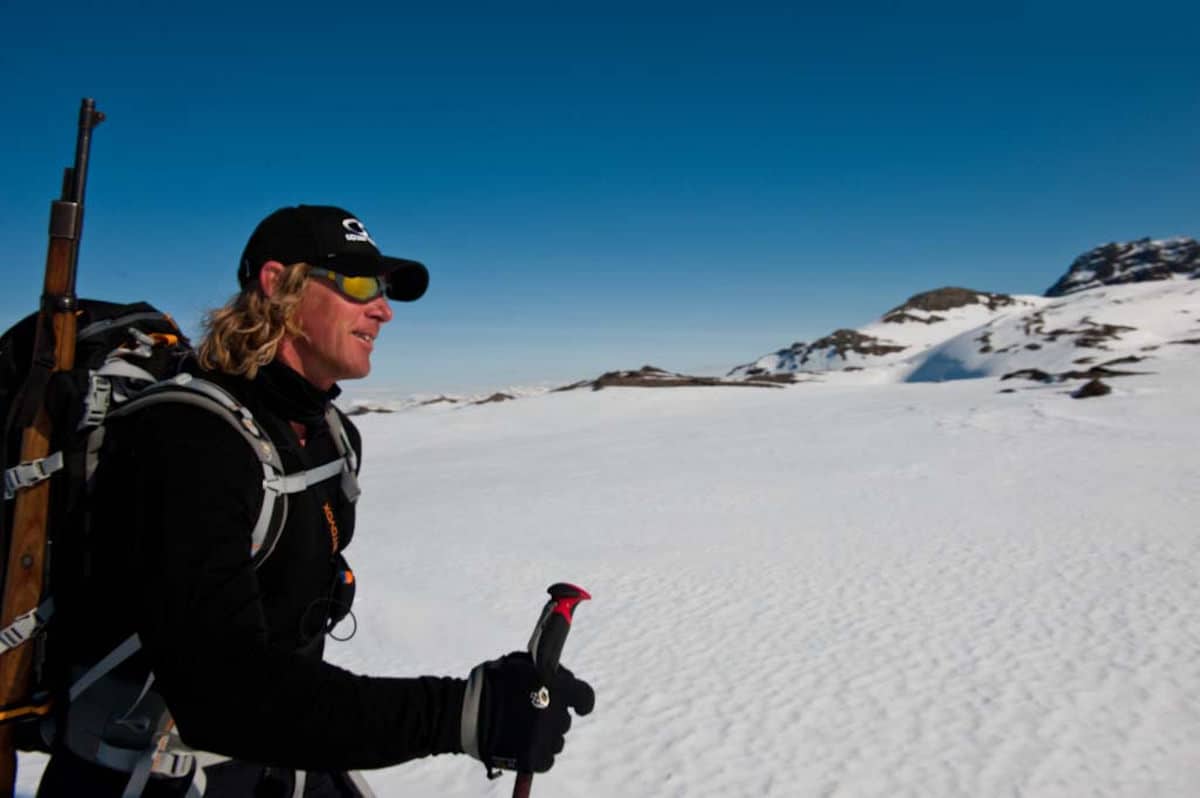
Gaël Couturier: When I listen to all you’ve been through, you make it sound like it’s very normal, like there is nothing special about all this. How do you manage to always stay safe out there? How are you still alive?
Douglas Stoup: I have experience and I am humble when it comes to nature. I might have a few guardian angels too. It is not normal, you’re right. I love pushing the limits of what is possible. I enjoy being in that flow state. You should read Rise to Superman by Steven Kotler. May be you will understand.
Gaël Couturier: Okay, will do. But tell me how far can you push the limits before it becomes addictive and unhealthy? Hear me out: base jumpers die often, alpinists die often, special forces military guys die often. All kind of extreme sports and activities are both exceptionally satisfying, but also awfully dangerous. French sociologist David Le Breton wrote “Passion du risque” in 1991 [literally “passion for risk], in which he states that it is when defying death that all the thrill-seekers get their satisfaction, their adrenaline shot. Have you ever felt that you went too far?
Douglas Stoup: I feel that I am constantly pushing the limits of what is humanly possible, but when you mention base-jumping; the margin of error in this activity is just so small. If something goes wrong with those guys once they are falling, there’s no calculation time to be able to fix something. The business that I am in allows me to understand the perimeter of my environment. I have time to control things and understand how to get away with them. I’m also usually focusing on trying to keep other people safe. For example, when we’ve been skiing for 14 hours and I ask my clients if they can ski for another hour and they say yes, we do go on. But if after 20 min, I don’t think it’s safe anymore, if I see they are not completely focused, I’ll just set up the tents so we can all get some rest. I train very, very hard for all of this and I would never want to be unprepared for an expedition. In case of a storm, I’m the one who can set up a tent and make it a shelter. We can’t lose our tents. If we do, we die. So when we happen to set up the tent in high wind, we have to tie ourselves to them to ensure they don’t accidentally go away. We also have to be extra careful with the poles. I usually bring an extra set of poles, in case we lose them. All of that is experience, preparation. I have been through it hundreds of times so I understand what can happen. Preparing for everything is the key to success. I sometimes secretly take weight out of other people’s sledges at night so we can be faster the next day. They may even say to me that they feel stronger on that day without noticing that they actually have less weight to carry. And I may slow down a little because of that extra weight but it’s all okay. Since the team is always as good as the weakest link, I don’t mind being that weakest link.
It’s a very civilized way of life for me and I certainly like to be able to push the limits of what is humanly possible at the same time.
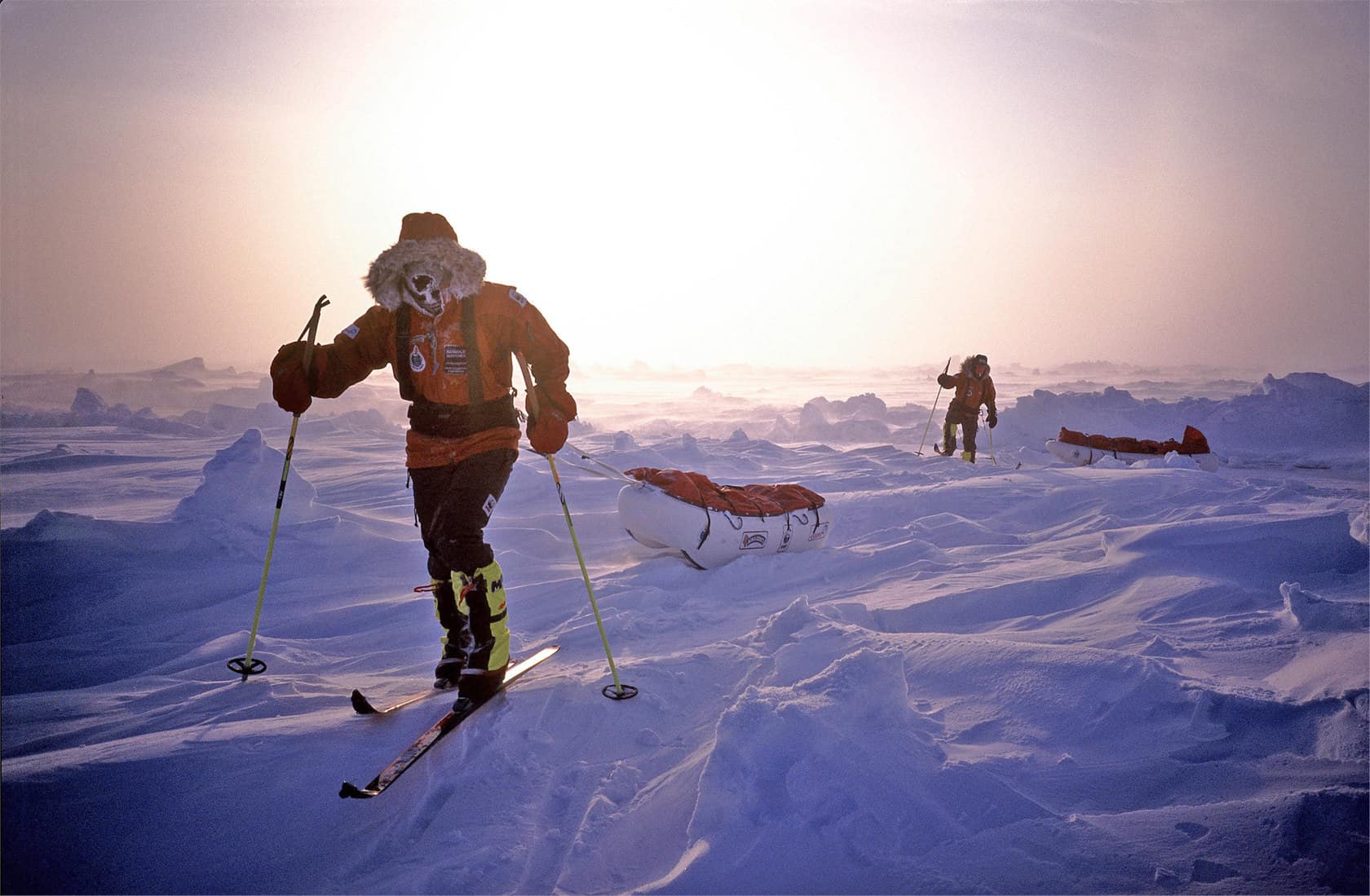
Gaël Couturier: Is the Arctic Ocean the most dangerous environment you travel to?
Douglas Stoup: Yes. It is a very unstable environment: always in flux, always moving. Sometimes it’s positive drift; sometimes it’s negative drift. The ice is being pushed around all the time. Reinhold Messner, the legendary Italian mountaineer who made the first ascent of Mount Everest without supplemental oxygen and also the first climber to ascend all 14 peaks over 8,000 meters (26,000 feet) above sea level, did a South and North Pole trip and he said that the North Pole is the hardest journey in the world—harder than any of the 8,000 peaks he’d done. When we ski across the Arctic Ocean, it is constantly in flux. Some days you’ll get positive drift, meaning that the ice is moving in the direction that you want to go and some days it is negative drift, meaning that you may ski 20 miles in a day but you get pushed back 5 or 6 miles while you’re resting in your tent at night. That’s life in the Arctic. So in the end, it comes down to the more time you’re out, awake and skiing, the more distance you’re going to travel. And then you have those polar bears. For most of the trips I lead, I don’t have any historical data of snowpack, weather conditions, etc., since so very few people have ever been to those places. I am very cautious and try not to take any unnecessary chances. But in the end, it’s all about mitigating risk.
Gaël Couturier: South Pole: all land surrounded by water, North Pole: all sea ice surrounded by land. You’ve taken 15 trips to each of those Poles. What’s so appealing about them? I mean, isn’t it just plain cold, most of the time miserable, extremely dangerous and also too white, I mean, a bit…boring?
Douglas Stoup: I have fallen in love with the polar environments. It’s like a rose. It has thorns but it also has so much beauty. I love the fact that it is a pristine untouched environment. I fell in love with Antarctica on my very first visit there, when I went to the highest peak, The Vinson Massif. Two months later, I chartered a Russian research vessel and pioneered skiing there. I saw millions of penguins, thousands of seals and hundreds of whales. Six months later, I was guiding a blind and deaf man from the coast to the geographic South Pole. It’s a love affair, an obvious attraction. I can’t help it.
Gaël Couturier: It sounds like you’re living in two different planets: one is ours, the civilized world; one is the wild, the frontier one. Do you sometimes have trouble coming back to us?
Douglas Stoup: I do. But when I am focused on an expedition, it is still very civilized to me: I get up early every morning, start the stove and melt ice/snow, pack up the supplies in the tent and start skiing. Once I have reached my goal, I don’t really want it to end. It takes several weeks after an expedition to re-socialize from it. Life on the ice is very simple. You go back to the basics. But I have a wife, a family. As much as I believe that every step forward is one step closer to them, I need to come back to them. Sometimes, when I’m in the middle of it, I dream of food. It strangely helps me forget about the suffering. I also think about putting my feet in the warm sand.

Gaël Couturier: Hi Alexandra! [His wife suddenly joins the conversation over the phone.] Tell me one thing: do you find Douglas Stoup sexy all the time, even when he’s not there with you?
Alexandra Woodward: We’ve only been together a year and a half, but so far I’m the one pushing him for more of those trips! I mean, he’s 53 years old, and I wonder how long he is going to be able to do it. I want him to keep the fight, I want him to go to Congress, to Capitol Hill and reveal what he sees, what very few people actually see. I think that’s his civic duty. I come from a political and diplomatic background. I want him to bring back here what he does on the field and speak out about it more. He does something unique and I push him to communicate more about this uniqueness because we are all really going to a very bad direction. I’m 45 myself and I had never been married before. We belong together—probably because of what he does. I couldn’t bear someone who would be home all the time.
Gaël Couturier: Douglas, what will you do when you retire?
Douglas Stoup: First things first: I look forward to doing an adventure with my family and with my wife very soon We’re going to the Amazon for 10 days, then we’ll go to Antarctica together. I look forward to that. It’s not super-extreme but it will be extremely fun. For me, it’s about sharing those beautiful amazing places. I can show them, and hopefully they can become ambassadors themselves. Now, to answer more specifically your question…I don’t think I’m ever going to retire. I’m going to continue to be a positive force on preserving and protecting our planet. I think when I’m 90 years old I’ll still be speaking with organizations and groups and try to get my message out there. If I’m still doing some of these trips, it’s only because I want to draw attention to important causes. It’s a very civilized way of life for me and I certainly like to be able to push the limits of what is humanly possible at the same time.
SUPping on the Amazon, September 2016


additional info:


